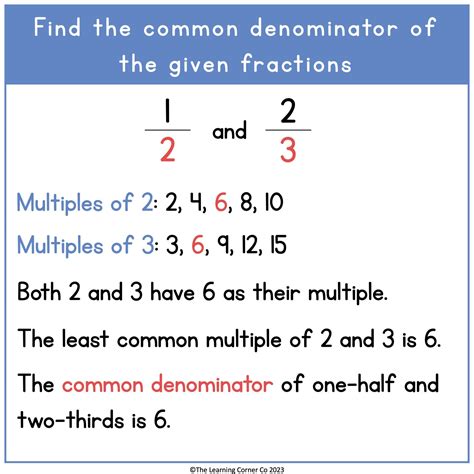How To Find The Common Denominator

Understanding the concept of a common denominator is crucial in mathematics, particularly when dealing with fractions. A common denominator is a common multiple of the denominators of two or more fractions, allowing for easy comparison, addition, and subtraction of these fractions. Finding the common denominator is a fundamental skill that simplifies various mathematical operations and enhances problem-solving capabilities. In this article, we will delve into the steps and strategies for finding the common denominator, exploring its importance, and discussing practical applications.
Key Points
- Understanding the concept of common denominators and their importance in fraction operations.
- Learning the step-by-step process to find the least common multiple (LCM) of two or more numbers.
- Applying the LCM to find the common denominator for fractions.
- Practical applications of common denominators in real-world scenarios.
- Strategies for simplifying fractions after finding a common denominator.
What is a Common Denominator?

A common denominator is a number that is a multiple of all the denominators of a set of fractions. It is the smallest number that each of the denominators can divide into evenly. For example, if we have the fractions 1⁄4 and 1⁄6, the common denominator would be 12 because 12 is the smallest number that both 4 and 6 can divide into without leaving a remainder.
Why is Finding a Common Denominator Important?
Finding a common denominator is essential when adding or subtracting fractions. Without a common denominator, these operations cannot be performed directly. By converting fractions to have the same denominator, we can easily add or subtract the numerators (the numbers on top) while keeping the denominator the same. This simplifies mathematical operations and is crucial for solving complex problems involving fractions.
How to Find the Common Denominator

To find the common denominator of two or more fractions, we first need to find the least common multiple (LCM) of the denominators. The LCM is the smallest number that is a multiple of all the numbers. Here are the steps to find the LCM:
- List the multiples of each number: Start by listing the multiples of each denominator. For example, if the denominators are 4 and 6, the multiples of 4 are 4, 8, 12, 16, 20, etc., and the multiples of 6 are 6, 12, 18, 24, etc.
- Identify the smallest common multiple: From the lists of multiples, identify the smallest number that appears in both lists. In our example, 12 is the smallest number that is a multiple of both 4 and 6.
- Use the LCM as the common denominator: Once the LCM is found, it can be used as the common denominator for the fractions. To convert each fraction to have this common denominator, multiply the numerator and the denominator by the same number. This number is found by dividing the common denominator by the original denominator of the fraction.
Example: Finding the Common Denominator for 1⁄4 and 1⁄6
Following the steps above, we first find the LCM of 4 and 6, which is 12. To convert 1⁄4 into a fraction with the denominator 12, we multiply both the numerator and the denominator by 3 (because 12 divided by 4 equals 3), resulting in 3⁄12. For 1⁄6, we multiply both the numerator and the denominator by 2 (because 12 divided by 6 equals 2), resulting in 2⁄12. Now, both fractions have the common denominator 12, and we can add or subtract them directly: 3⁄12 + 2⁄12 = 5⁄12.
| Denominator | LCM | Common Denominator |
|---|---|---|
| 4 | 12 | 3/12 |
| 6 | 12 | 2/12 |

Practical Applications of Common Denominators
Common denominators have numerous practical applications in real-world scenarios, including cooking, finance, and construction. For instance, when following a recipe that requires combining ingredients in fractional amounts, finding a common denominator can simplify the measurement process. In finance, understanding common denominators can help in comparing interest rates or investment returns. In construction, calculating materials needed for a project may involve adding fractions, which requires finding a common denominator.
Simplifying Fractions After Finding a Common Denominator
After finding the common denominator and performing the desired operation (addition or subtraction), it’s often possible to simplify the resulting fraction. Simplification involves dividing both the numerator and the denominator by their greatest common divisor (GCD). This step is crucial for presenting the answer in its simplest form, which is usually required in mathematical and real-world applications.
What is the purpose of finding a common denominator?
+The purpose of finding a common denominator is to enable the addition or subtraction of fractions by converting them to have the same denominator, thus simplifying mathematical operations.
How do you find the common denominator of two fractions?
+To find the common denominator, first, find the least common multiple (LCM) of the denominators. Then, convert each fraction to an equivalent fraction with the LCM as the denominator by multiplying the numerator and the denominator by the appropriate factor.
Why is simplifying fractions important?
+Simplifying fractions is important because it presents the fraction in its simplest form, making it easier to understand and work with in subsequent mathematical operations or real-world applications.
In conclusion, finding the common denominator is a critical skill in mathematics that facilitates the comparison and combination of fractions. By understanding how to find the least common multiple of denominators and applying it to convert fractions to have a common denominator, individuals can enhance their problem-solving capabilities in various mathematical and real-world contexts. Remember, the key to mastering common denominators lies in practice and applying the concept to solve problems, which over time, becomes second nature.



